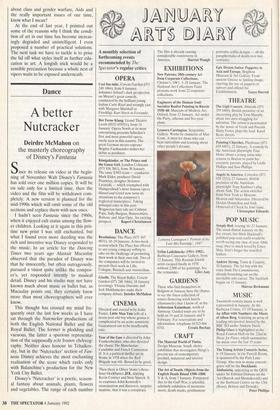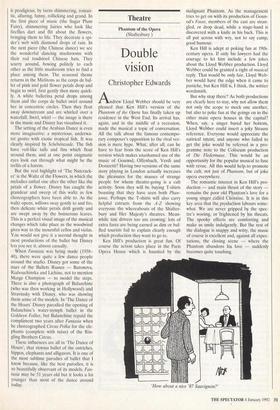Dance
A better Nutcracker
Deirdre McMahon on the masterly choreography of Disney's Fantasia Since its release on video at the begin- ning of November Walt Disney's Fantasia has sold over one million copies. It will he on sale only for a limited time, then the video and the film will be withdrawn com- pletely. A new version is planned for the mid-1990s which will omit some of the old sections and replace them with new ones.
I hadn't seen Fantasia since the 1960s, when it enjoyed cult status among the flow- er children. Looking at it again in this pris- tine new print I was still enchanted, but what I found even more dazzling was the rich and inventive way Disney responded to the music. In an article for the Dancing Times two years ago Alastair Macaulay oberved that the paradox of Disney was that he innocently, but often outrageously, pursued a vision quite unlike the compos- er's, yet responded intently to musical detail. Disney and his studio may not have known much about music or ballet but, as Macaulay points out, they certainly knew more than most choreographers will ever know.
This thought has crossed my mind fre- quently over the last few weeks as I have sat through the Nutcracker productions of both the English National Ballet and the Royal Ballet. The former is plodding and vacuous, the latter a spurious representa- tion of the supposedly echt Ivanov chdreog- raphy. Neither does honour to Tchaikov- sky, but in the 'Nutcracker' section of Fan- tasia Disney achieves the most enchanting realisation of the score which ranks only with Balanchine's production for the New York City Ballet.
Disney's 'Nutcracker' is a poetic, season- al fantasy about animals, plants, flowers and vegetables. The range of each number is prodigious, by turns shimmering, roman- tic, alluring, funny, rollicking and grand. In the first piece of music (the Sugar Plum Fairy), shimmering fairies who look like fireflies dart and flit about the flowers, bringing them to life. They decorate a spi- der's web with diamond drops of rain. In the next piece (the Chinese dance) we see the wonderful dancing mushrooms with their red toadstool Chinese hats. They scurry around, bowing politely to each other as the little mushroom tries to find a place among them. The seasonal theme returns in the Mirlitons as the corps de bal- let of pink and gold flower petals drop and begin to swirl, first gently then more quick- ly. A white ballerina petal drops among them and the corps de ballet swirl around her in concentric circles. Then they float away downstream and are whirled over a waterfall. Swirl, whirl — the image is there in the music and Disney has visualised it.
The setting of the Arabian Dance is even more imaginative: a mysterious, underwa- ter grotto with exotic tropical fish. It was clearly inspired by Scheherazade. The fish have veil-like tails and fins which float around them, and at one point enigmatic eyes look out through what might be the trellis of a harem.
But the real highlight of 'The Nutcrack- er' is the Waltz of the Flowers, in which the melodies unfurl one after the other like the petals of a flower. Disney has caught the grandeur and sweep of this waltz as few choreographers have been able to. As the waltz opens, willows sway gently to and fro, then delicate white petals drift gently and are swept away by the boisterous leaves. This is a perfect visual image of the musical changes which take place as the woodwind gives way to the mournful cellos and violas. You would not give it a second thought in most productions of the ballet but Disney lets you see it, almost casually.
When Fantasia was being made (1938- 40), there were quite a few dance people around the studio. Disney got some of the stars of the Ballets Russes — Baronova, Riabouchinska and Lichine, not to mention Marge Champion — to model the steps. There is also a photograph of Balanchine (who was then working in Hollywood) and Stravinsky with Disney, who was showing them some of the models. In 'The Dance of the Hours' Disney parodied the opening of Balanchine's water-nymph ballet in the Goldwyn Follies, but Balanchine repaid the compliment two years after Fantasia when he choreographed Circus Polka for the ele- phants (complete with tutus) of the Rin- gling Brothers Circus.
These influences are all in 'The Dance of Hours', that riotous ballet of the ostriches, hippos, elephants and alligators. It is one of the most sublime parodies of ballet that I know because, like the best parodies, it is
so beautifully observant of its models. Fan- tasia may be 51 years old but it looks a lot younger than most of the dance around today.











































 Previous page
Previous page